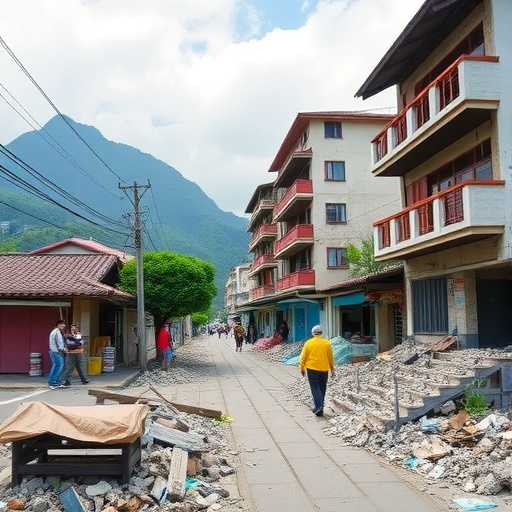In the realm of natural disasters, resilience is often heralded as a critical attribute enabling communities and systems to withstand, adapt to, and recover from catastrophic events. Yet, despite its frequent mention, the multi-faceted nature of resilience and how its various attributes interplay across different stages of disaster management have rarely been dissected in depth. A groundbreaking study published in the Bulletin of the Seismological Society of America now addresses this gap by meticulously analyzing the organizational and structural dynamics influencing resilience during earthquake disasters in Taiwan.
Hsiang-Chieh Lee and collaborators from the National Science and Technology Center for Disaster Reduction embarked on a thorough observational study to probe the responses of local governments to two significant seismic events: the 2016 Tainan earthquake and the 2018 Hualien earthquake. Both quakes caused substantial casualties and infrastructural damage, furnishing a rich dataset for examining resilience as a composite of interacting traits in the face of real-world adversity.
Central to Lee’s study is the identification of thirteen distinct attributes of resilience, each encapsulating different capacities and strategies that collectively bolster disaster management effectiveness. These attributes include agility—defined as the capability to swiftly react to unforeseen challenges—and diversity, which reflects the employment of varied solutions and technologies to mitigate the risks of systemic failure. Other essential qualities highlighted encompass foresight capacity, modularity in organization, and redundancy, each contributing unique strengths across disaster phases.
One of the study’s pivotal insights reveals that these resilience attributes do not operate uniformly throughout disaster management but become selectively salient during specific phases. For instance, agility emerges as a dominant feature both in preparedness—enabling swift readiness measures—and in the immediate response stage, facilitating rapid adaptation. Conversely, resourcefulness is predominantly critical during the preparatory phase, where efficient use of available assets lays the groundwork for effective coping mechanisms.
Creativity and connectivity are pinpointed as particularly crucial during active response operations. Lee explains that when predefined preparedness plans fail to fully address emerging challenges, a resilient system taps into on-the-spot innovation and leverages extensive networks to mobilize necessary resources. This dynamic interplay underscores the importance of flexible thinking and robust information exchange capabilities during crisis periods.
Despite the apparent necessity of improvisation during disasters, the researchers caution against equating resilience solely with reactive adaptation. Their findings consistently emphasize that all key resilience attributes are intrinsically tied to proactive, pre-disaster preparation efforts. In other words, the foundation of effective resilience lies in meticulous, anticipatory planning grounded in a thorough understanding of potential hazards and vulnerabilities.
The two earthquakes under study provide a compelling comparative framework. The 2016 Tainan earthquake, registering magnitude 6.6, tragically resulted in the highest number of fatalities linked to a single building collapse in Taiwan’s history. Subsequently, the 2018 Hualien earthquake of magnitude 6.2 inflicted further casualties and infrastructural setbacks. The temporal proximity between these events offered a unique opportunity to assess how lessons learned and institutional memories influenced disaster response and collaboration in subsequent crises.
A salient feature observed in both events was the robust collaboration between public entities and private organizations. This public-private synergy emerged as a crucial factor enhancing resilience. The study delineates the distinctive yet complementary roles each sector plays: governmental agencies usually spearhead preparedness initiatives, driven by their authoritative mandates and organizational capacities. However, during the acute response phase, when governmental resources and capabilities face limitations, the private sector’s diversity, creativity, and extensive networks become indispensable in sustaining recovery operations.
This nuanced understanding of sectoral contributions challenges traditional paradigms of disaster management that often prioritize public institutions as primary agents of resilience. Instead, Lee and colleagues advocate for an integrated model where cross-sector collaboration is not an ancillary feature but a cornerstone of effective resilience-building strategies.
Methodologically, the research draws on first-hand interviews with key responders involved in both earthquakes, supplemented by secondary sources including government reports and media documentation. This multi-source information triangulation strengthens the robustness of the analysis and affords a comprehensive view of the complexities inherent in disaster resilience.
Importantly, the researchers envision that their resilience attributes framework transcends earthquakes, offering a versatile foundation applicable to other hazard types such as wildfires and floods. This transdisciplinary applicability underscores the universal value of understanding resilience not as a static trait but as a dynamic system capable of modulation according to specific disaster contexts.
To ensure the practical utility of their findings, Lee and the team are actively preparing an accessible guidebook tailored for Taiwan’s 22 municipalities. This initiative aims to disseminate actionable insights widely among local governments, academic institutions, and NGOs, fostering a culture of informed and collaborative disaster preparedness and response.
The publication of this study coincides with the twenty-fifth anniversary of the devastating 1999 Chi-Chi earthquake, a seminal event that profoundly shaped Taiwan’s seismic risk awareness and mitigation policies. By situating their research within this historical arc, the authors reinforce the enduring importance of learning from past experiences to inform future resilience strategies.
Ultimately, this comprehensive examination of resilience as an interaction of multiple, phase-dependent attributes subjected to the crucible of real disasters represents a significant advance in seismological and disaster management sciences. It prompts a reevaluation of how disaster risk reduction is conceptualized and operationalized, highlighting the necessity of integrated, anticipatory action underpinned by versatile public-private cooperation.
As the frequency and intensity of natural disasters escalate globally, insights such as those offered by Lee and colleagues are indispensable. They equip societies not only to endure the shocks of catastrophic events but to emerge from them with strengthened adaptive capacities and renewed resolve toward sustainable disaster risk reduction.
Subject of Research: Not applicable
Article Title: Attributes of Resilience in Disaster Response and Preparedness: Public–Private Collaboration During the 2016 and 2018 Earthquakes in Taiwan
News Publication Date: 4-Sep-2025
Web References: http://dx.doi.org/10.1785/0120250069
Keywords: Earthquakes, Natural disasters




